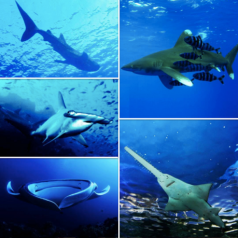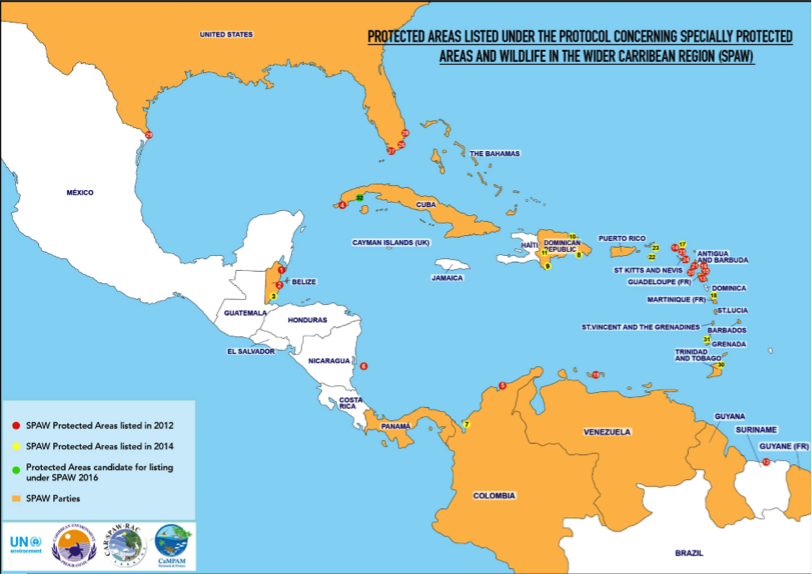
On Monday, March 13th , the Meetings of the Contracting Parties to the Cartagena Convention will start in Cayenne, French Guyana, where there will be a formal vote on the proposals to list the smalltooth sawfish, oceanic whitetip shark, whale shark, manta rays and hammerhead sharks on the Specially Protected Areas and Wildlife (SPAW) Protocol. This marks the first cross-border protective management in a Wider Caribbean context for elasmobranch species. As SPAW and the Cartagena Convention are very little known legislative instruments, we made a short overview of what they are and what is proposed.
The Cartagena Convention
The Convention for the Protection and Development of the Marine Environment in the Wider Caribbean Region (WCR) is the only legally binding regional environmental treaty for the Region. The Convention, referred to as the Cartagena Convention, presently has 25 (out of 28 possible) States that are Contracting Parties. The Convention and its Protocols constitute a legal commitment by these countries to protect, and manage their common coastal and marine resources individually, and jointly in a sustainable manner.
Specially Protected Areas and Wildlife (SPAW) Protocol
Adopted in Kingston, Jamaica by the member governments of the Caribbean Environment Programme (CEP) on 18 January 1990, the SPAW Protocol preceded other international environmental agreements in utilizing an ecosystem approach to conservation. The Protocol acts as a vehicle to assist with regional implementation of the broader and more demanding global Convention on Biological Diversity (CBD). 14 of the 25 signatories to the Cartagena convention have now ratified the protocol.

Map showing countries that have ratified the protocol, parties that have signed the Cartagena convention but not the protocol are: Antigua and Barbuda, Costa Rica, Dominica, Guatemala, Jamaica, Mexico, Nicaragua, St. Kitts & Nevis and the United Kingdom.
The protocol is set up for protection of the unique and or fragile biodiversity of the Caribbean by obliging signatories to the protocol to take the necessary measures to protect, preserve and manage in a sustainable way, in areas of the Wider Caribbean Region in which it exercises sovereign rights of jurisdiction: (a) areas that require protection to safeguard their special value; and (b) threatened and endangered species.
The protocol deals with area protection for unique and/or fragile habitats and has three annexes that deal with species-specific protection. Annex I is for plants, Annex II for threatened and endangered fauna for which the signatories shall ensure total protection and recovery by prohibiting (i) the taking, possessing or killing (including, to the extent possible, the incidental taking possession or killing) or commercial trade in such species, their eggs, parts or products. (ii) to the extent possible, the disturbance of such species, particularly during periods of breeding, incubation, estivation or migration, as well as other periods of biological stress. Species that are at risk of becoming threatened unless populations are managed sustainably are listed in Annex III. With regard to the species listed in Annex III, each Party shall, in cooperation with other Parties, formulate, adopt and implement plans for the management and use of such species including: (a) the prohibition of all non-selective means of capture, killing, hunting and fishing of all actions likely to cause local disappearance of a species or serious disturbance of its tranquility, (b) the institution of closed hunting and fishing seasons and other measures of maintaining their population, (c) the regulation of the taking, possession, transport or sale of dead specimens, their eggs, parts or products.
Species proposed by the Netherlands in 2016
In order for a species proposal to be considered, one member state has to present a justification to the SPAW Scientific and Technical Committee. The Netherlands (representing the Dutch Caribbean islands of Bonaire, Saba and Statia) presented proposals for eight species they deemed the most likely candidates to qualify for listing and which had a part of their distribution in the region. As listing in the Convention on International Trade of Endangered Species (CITES) is a strong criterion for SPAW, only species were selected that were listed in CITES on July 2016 (when the proposals were due). These are smalltooth sawfish, oceanic whitetip shark, whale shark, two species of manta ray (and the new Caribbean sub species) and three species of hammerhead shark.
The listing proposals were accepted at the SPAW Scientific Technical meeting in Miami on the 1st of November with sawfish accepted for Annex II (full protection) and the other species for Annex III (protective management). France voiced strong support for the shark proposals, as well as for the sawfish proposal.
On Monday March 13th 2017, the SPAW Conference of the Parties will be held in Cayenne, French Guyana, where there will be a formal vote on the proposals for listing. Only a 60% majority vote is needed for the listings to be approved, so it is expected that they will pass with no opposition.





